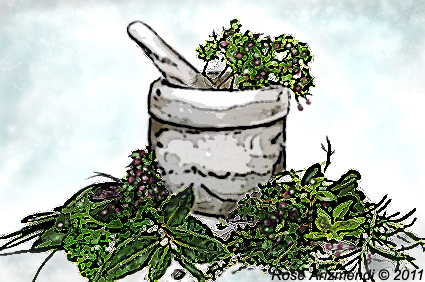Herbal Basics

What you will need to get started are a few tools. One of the few rules that you will need to follow is not to use aluminum or copper pans for preparing herbs. Both metals are detrimental to the quality of the herbs. Aluminum pans should be avoided, as the metal may be released in unsafe amounts into the preparation during cooking and can be quite toxic. Copper may destroy the vitamin C content of certain foods. We use glass, stainless steel, ceramic, enamel, and iron pots for herbal preparations. Each herbalist has her own preferences, and you will hear a lot of pros and cons for each. We suggest that you experiment and make your own choices. You will also need large wooded spoons, and measuring cups. The purchase of a potato ricer, which you can line with cheesecloth, will make an inexpensive hand press. I also suggest a coffee grinder for powdering and grinding herbs. Nut grinders are also useful. Do not use this coffee grinder for any other purpose, otherwise your coffee will taste funny and your herbs will smell and taste like coffee. The following items you will need are:
- A large stainless steel, fine meshed strainer.
- Cheese cloth for straining herbs.
- A hand grater used only for grating beeswax.
- Recipe box and blank recipe cards.
- Glass bottles and jars for storing your herbal preparations.
- Self-adhesive labels for your containers.
- Large and small muslin drawstring bags from you local health food store.
- Small crock pot.
- An Herbal Journal to record your herbal notes and thoughts. Divide this journal into seasonal sections. This will help you identify reoccurring patterns and seasonally associated health issues.
Herbal Medicine Chest
The first step in learning about herbalism is to select a small group of herbs to learn about. There are over two thousand or so plants that can be used medicinally. Select only 10 to15 herbs to begin with, it is far easier to develop your knowledge and skills on a few, rather than having many herbs that you know little about. Try growing herbs that you are attracted to in your garden. Most of the herbs listed can be found in health food and herb stores. Learn as much as you can about the usage, history and folklore of each plant you will be using. Learn about each herb by consulting more than one source. Books written by practicing herbalists are the ones we suggest. Herbs make wonderful allies, treat them with respect and they will enhance your life force with theirs. The following are some of our favorites.
Aniseed
Pimpinella anisum
Use the herb to ease gas, flatulence, and intestinal colic. To make an infusion pour one cup of boiling water over 1-2 teaspoonfuls of slightly crushed seeds and let sit for 4 to 8 minutes.
Chamomile
Matricaria chamomilla
This herb is an excellent gentle sedative. We use it for indigestion and gastritis. A friend gave me a recipe for Reflux problems and it works great. The recipe is one part chamomile and one part red clover blossoms, blend well. Use as a mouthwash for inflammations of the mouth, or as a fine addition to any skin care preparations. This herb is renowned for its medicinal and household use.
Cramp Bark
Viburnum opulus
Cramp Bark relaxes the uterus and relieves painful cramps associated with periods and muscular cramps. I use it for bleeding associated with menopause.
Dandelion
Taraxacum officinale
Dandelion is a diuretic, but unlike pharmaceutical diuretics, it is high in potassium. This makes it an ideally balanced diuretic that may be used safely. This wonderful herb makes a great general tonic, and aids the body in building and restoring reserves. You can add the fresh leaves to salads or soups. A decoction is made of the roots. To make a decoction place 1-3 teaspoonfuls of root into one cup of water. Bring to a boil and simmer for10-15 minutes.
Echinacea
Echinacea angustifolia, A. purpurea
Echinacea helps the body rid itself of infections. It is used against both bacterial and viral attacks. It strengthens the immune system and helps build resistance to flu, colds and most infections. It’s easy to grow and is a garden perennial.
Ginger
Zingiber officinale
We use this herb for poor circulation, colds, stomach cramps and sore throats. I make Ginger tea with lemon, honey when I am feeling under the weather, and serve it iced in summer and hot in winter. My friend uses it for menstrual irregularities.
Nettles
Urtica dioica
Nettles strengthen and support the whole body. It is one of the highest sources of digestible iron; it is also rich in calcium and vitamin A. I use the dried herb for fatigue, menstrual problems, and anemia. I also use dried nettles in my homemade shampoos. Beware of using fresh leaves, they can raise blisters on the skin.
Peppermint
Mentha piperita
This herb is great in most tea blends. Use for travel sickness, colds, upset stomachs, and nausea. Peppermint is used in tea blends to enhance the flavor of other medicinal herbs that do not taste very good. This herb also helps to repel ants.
Skullcap
Scutellaria laterifolia
One of the best nervines available. It relieves states of nervous tension while at the same time revitalizing the entire nervous system. It helps to relieve pre-menstrual tension and headaches. It combines well with valerian.
Valerian
Valeriana officinalis
This herb is excellent for nervous stress, insomnia, headaches and tension. It is indicated where pain is associated with tension. It is non-habit forming and non-addictive. This herb does not smell very good, but is a staple in my herb pantry.
